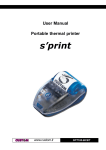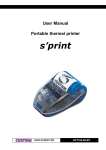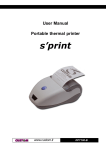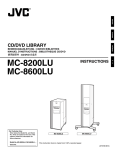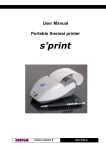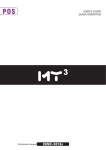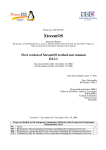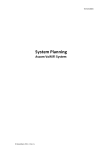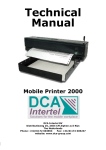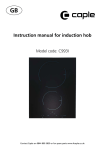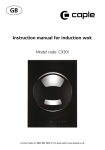Download DCA Intertel s'print BT User manual
Transcript
User Manual s’print BT Portable thermal printer DCA Intertel BV Distributieweg 25, 2404 CM Alphen a/d Rijn The Nederlands Phone: +31(0)172 604963 Fax: +31(0)172 605237 website: www.dca-group.com DCA Intertel 1 DCA Intertel TABLE OF CONTENS PRINTER COMPONENTS 6 A. DPT100-B – Front external view 6 B. DPT100-B – Under view 7 INTRODUCTION 8 MANUAL ORGANIZATION 8 SYMBOL USED IN THIS MANUAL 8 GENERAL SAFETY INFORMATION 8 UNPACKING THE PRINTER 9 PRINTER FEATURES 10 PRINTER DESCRIPTION 11 1. INSTALLTION AND USE 1.1 CONNECTIONS 1.1.1 Battery Recharger 1.1.2 Turning the printer On and Off 1.2 BATTERIES 1.2.1 Recharging batteries 1.2.2 Information regarding battery use 1.2.3 Replacing batteries 1.2.4 Disposing of batteries 1.3 CONFIGURATION 1.3.1 Configuration Mod. DPT100-B/I 1.3.2 Configuration Mod. DPT100-BT 1.4 HEXADECIMAL DUMP 1.5 SIXLOAD 1.6 MAINTENANCE 1.6.1 Changing the paper roll 1.6.2 Cleaning 13 13 13 14 15 15 16 16 18 19 19 21 23 23 24 24 26 2. INTERFACES 2.1 RS232 SERIAL 2.2 INFRARED BIDIRECTIONAL SERIAL (only DPT100-B model) 2.2.1 Standard Mode 2.2.2 InfraRed communication protocol 2.2.3 Printing instructions 2.3 IrDA PROTOCOL OVERVIEW (only DPT100-I model) 2.3.1 IrDA DATA PROTOCOLS SUPPORTED 2.3.1.1 Physical Signal Layer(PHY) 2.3.1.2 IrLAP 2.3.1.3 IrLMP 27 27 30 30 31 33 34 35 35 35 36 DCA Intertel 2 DCA Intertel 2.3.1.4 Link Management-Information Access Service (LM-IAS) 2.3.1.5 IrCOMM 2.3.1.5.1 3-Wire Raw and IrLPT in Detail 2.3.1.5.2 How 3-Wire raw and IrLPT differ 2.3.1.5.3 IAS entry and hint bits 2.3.1.5.4 Basic link operation 2.4 BLUETOOTH PROTOCOL OVERVIEW (Only mod. DPT100-BT) 2.4.1 Supported Protocols 2.4.1.1 Serial Port Profile 2.4.1.2 Object Push Profile 36 37 37 37 38 38 39 40 41 41 3. PRINING FUNCTIONS 3.1 CONTROL CHARACTERS 42 42 4 TECHNICAL SPECIFICATIONS 4.1 Technical Specifications 4.2 ADAPTOR SPECIFICATIONS 4.3 DIMENSIONS 56 56 58 59 5. CHARACTER SETS 60 APPENDIX A - ACCESSORIES AND SPARE PARTS A.1 TICKET ALIGNMENT A.1.1 Ticket alignment A.1.2 Alignment Description A.2 ACCESSORIES A.3 SPARE PARTS 61 61 61 61 62 62 DCA Intertel 3 DCA Intertel PRINTER COMPONENTS A. DPT100-B – Front external view 1234567- Printer base Cover Paper holder Printing mechanism Multi-function + ON key Paper exit slot Infrared device DCA Intertel 4 DCA Intertel B. DPT100-B – Under view 1- Serial connector and battery recharger 2- Battery compartment DCA Intertel 5 DCA Intertel INTRODUCTION MANUAL ORGANIZATION In addition to the Introduction which includes a description of the explanatory notes used in the manual, general safety information, how to unpack the printer and a brief description of the printer including its basic features, this manual is organized as follows: Chapter 1: Contains the information required for correct printer installation and its proper use, as well as interface specifications Chapter 2: Contains information on interface specifications Chapter 3: Contains a description of the printer command set Chapter 4: Contains Technical Specifications of the printer Chapter 5: Contains the character sets (fonts) used by the printer SYMBOL USED IN THIS MANUAL NOTE Gives important information or suggestions relative to the use of the printer. WARNING Information marked with this symbol must be carefully followed to guard against damaging the printer. DANGER Information marked with this symbol must be carefully followed to guard against operator injury or damage. GENERAL SAFETY INFORMATION -Read and keep the instructions which follow. -Before cleaning the printer, disconnect the power supply and make sure that the printer is off. -Clean the printer with a damp cloth. Do not use liquid or spray products. -Do not operate the printer near water. -Only use approved accessories and batteries. Do not connect to products that are not compatible. -Use the type of electrical power supply indicated on the printer label. If in doubt, contact your retailer. -When deciding where to place the printer, make sure it is positioned where its cables will not be damaged. -Do not introduce foreign objects of any kind into the printer as they could cause a short circuit and could jeopardize printer functioning. -Do not spill liquids onto the printer. -Do not carry out technical operations on the printer, with the exception of the scheduled maintenance procedures specifically indicated in the user manual. -Disconnect the printer from the electricity supply and have it repaired by a specialized technician when: A. The feed connector has been damaged. B. Liquid has seeped inside of the printer. C. The printer has been exposed to rain or water. DCA Intertel 6 DCA Intertel D. The printer is not functioning normally despite the fact that all instructions in the users manual have been followed. E. The printer has been dropped and its outer casing damaged. F. Printer performance is poor. G. The printer is not functioning. UNPACKING THE PRINTER Remove the printer from its carton being careful not to damage the packing material so that it may be re-used if the printer is to be transported in the future. Make sure that all the components illustrated in figure are present and that there are no signs of damage. If there are, contact DCA Intertel. 1. 2. 3. 4. 5. 6. 7. 8. Warning sheet Cable Paper roll Adaptor / Battery recharger Batteries (5 pcs.) Belt coupler Printer Box DCA Intertel 7 DCA Intertel PRINTER FEATURES The new s’ print portable thermal printer offers an innovative alternative to impactbased systems, with a range of interface options (RS232 serial,R232+IRDA, RS232+Bluetooth). The printer is powered using batteries. The battery version (with RS232+IRDA interface) is primarily intended for the automatic identification and mobile telephony market, combined with portable terminals without printer; the infrared bidirectional interface with which it is equipped makes cable connection—so “inconvenient” for portable devices—unnecessary. The BT version is powered by batteries (5 rechargeable AA penlight batteries), and communicates through RS232 serial interface and Bluetooth(TM). s’print-BT is a light weight and slim printer. By means of the Bluetooth(TM) wireless technology it is capable to print wireless at high speed without any alignment. The ideal and best match of s’print-BT is together with PDAs, mobile phones, laptop computers, and automatic ID devices. The supported Bluetooth(TM) profiles are SPP (Serial Port Profile) that provides RS232 serial cable emulation, and OPP (Object Push Profile) enabling the print-out of vCard format objects (business cards). It is important to note that s’ print is the first printer designed with “sixload” easy paper load, making it simpler and more convenient to use. It has a 203 dpi thermal print mechanism that utilizes 57.5mm-wide paper rolls and can print up to 24 o 40(1) charaters per line. NOTE The 40 column version is downloadable on the Support/Download/ Firmware section from www.dca-group.com web site. DCA Intertel 8 DCA Intertel PRINTER DESCRIPTION The printers consists of a ABS-V0 casing (1) equipped with a cover (2) under which is housed the paper roll and print mechanism. On the front is the multifunction key (3) and red LED (4). Multi-function key. This key is used to access a variety of printer option sdepending on how long it is held down. If the printer is off (red LED off), when this key is pressed power is turned on (blinking red LED). To turn the printer off the key is pressed two times (the LED begins to blinkfaster) and if it is not pressed again within three seconds the printer shuts off. During the power-up phase, if the key is held down for at least three seconds, the printer enters the configuration mode and prints out a printer setup report. When the print-out is complete, the printer remains in stand-by to receive characters from the serial interface that are printed out in hexadecimal code. If the key is pressed, the printer by-passes the setup mode and terminates the hexadecimal dump function. Pressing the key quickly will exit the configuration mode, while if it is held down for at least a second, it is possible to make changes in the individual parameters. DCA Intertel 9 DCA Intertel The red LED displays printer operating status and this check is performed “on-line”. Table 1 lists operating statuses and the LED signals connected to them: LED Status Description Always off Printer off Always on Printer on - no fault with batteries recharing very slow blinking (one blink every three seconds) Printer on - no fault with batteries recharing slow blinking (one blink every second) Paper out message fast blinking (one blink every half second) Resettable error (heat overheating, battery voltage error) Very fast blinking (seven blinks per second) In process of shutting off DCA Intertel 10 DCA Intertel 1. Installtion and Use 1.1 CONNECTIONS 1.1.1 Battery Recharger For the Battery Recharger/Power Supply and serial connection, the printer is equipped with a connecting cable (fig. 1.2) that comes packed with the printer and has a double connection system. On one side is a 9-pin female connector (fig. 1.2.A) for the serial port; on the other side of the same connector is a RJ11 connector (fig. 1.2.B) and a jack (fig. 1.2.C) for connection to the battery recharger. The printer is equipped with a rechargeable battery pack, located in the battery compartment (2), self-sufficient for printing. To recharge the batteries, use the connection cable (fig. 1.2) that comes packed with the printer and following the instructions reported in the 1.2.1 paragraph. DCA Intertel 11 DCA Intertel 1.1.2 Turning the printer On and Off How to turn the printer On • by briefly pressing the multi-function key • by sending a characters set on the serial line—it is better to send characters that are not read as printer controls (ex. 0x0E) • with the battery recharger connected How to turn the printer Off (1) • by briefly pressing the multi-function key • by sending the character ESC 0 over the serial line • following a given period of inactivity as specified in setup (see sec. 1.3) (1) NOTE If the printer is connected to the battery recharger and it recharging the batteries it’s not possible to turn off the printer. It must wait that the operation in terminated. Turning the printer On and Off using software commands If the printer is off, sending a characters set on the serial line will turn it on (2)(3). Follow the instructions shown in the diagram below: (2) NOTE It’s not possible to turn on the printer sending one or more characters through the infrared device. (3) NOTE The printer start up will not occur before 200-250 msec. This delay is caused by internal component. DCA Intertel 12 DCA Intertel 1.2 BATTERIES 1.2.1 Recharging batteries Appearing in the printer set up print out (see sec. 1.3) is the parameter HEAD VOLT that gives the battery charge level. To recharge the batteries(4), use the cable packed with the printer and proceed as follows: - Connect the battery recharger jack to the cable jack (vedi fig. 1.4) and plug the battery recharger into the electrical mains; - Connect the cable RJ11 connector to the RJ11 connector located under the printer (see fig. 1.4). For a complete recharge, we recommend that the batteries be left to charge for two hours; (4) NOTE During the recharge operation it’s not possible turning the printer off. WARNING Incorrect battery recharge voltage (different from that given in tab. 1.2) could seriously damage the printer. Tables 1.1 and 1.2 provide specifications for the battery recharger Pin Signal IN/OUT Description 1 +VRIC Power Battery recharge 2 GND Power Ground signal DCA Intertel MAX recharge current 0.6 A MAX recharge voltage 12V - 36V 13 DCA Intertel 1.2.2 Information regarding battery use - Please note that the new NiMH battery reaches maximum performance levels only after having been completely discharged and recharged at least two or three times. - Never use battery rechargers and/or batteries that are damaged or worn. - Battery life varies greatly depending, for example, on print density and the text to be printed. - Recharge times vary depending on depletion levels, type of battery and battery recharger used. Batteries may be recharged and discharged hundreds of times, but they do wear out over time. When battery life (both print and stand-by) is noticeably shorter than usual, it is time to buy a new battery. - Only utilize batteries that conform to specifications and only recharge them using battery rechargers approved by DCA Intertle BV. - When the battery recharger is not in use, unplug it from the electrical mains. If not used, even a completely-charged battery will automatically discharge over time. - NiMH batteries last longer if you remember to completely discharge them every so often. - Extreme temperatures can affect battery charge levels—leave them to cool or warm as required. 1.2.3 Replacing batteries Instead of the rechargeable battery pack supplied with the printer, 5 AA ALKALINE penlight batteries may be used(5)(6). (5) Note: if batteries other than those supplied with the printer are used, the Battery parameter in setup must modified and the settings changed to Alkaline if Alkaline batteries are used, or the to closest reference value for other types of batteries (see sec. 1.3). (6) Note: if Alkaline batteries are used it doesn’t make the recharge. DCA Intertel 14 DCA Intertel To replace batteries, proceed as follows: - Remove the cover on the battery compartment (1) by unscrewing the screws (2) and, using a flat-head screwdriver, pry open at points A and B (see fig.1.5). - Remove the battery pack (2) by lifting the battery removal tape (1) (see fig. 1.6). DCA Intertel 15 DCA Intertel - Insert the 5 batteries(7) inside the compartment following the layout indicated in fig. 1.7 and re-position the battery removal tape; (7) Note: when inserting the batteries, make sure the + and – signs are positioned correctly. - Reclose the battery compartment by tightening the fastening screws. 1.2.4 Disposing of batteries - Batteries must be recycled or disposed of properly. Do not throw batteries away as part of normal refuse disposal. - Do no throw batteries into open flame! DCA Intertel 16 DCA Intertel 1.3 CONFIGURATION 1.3.1 Configuration Mod. DPT100-B/I The printer set up print out (see fig. 1.9) includes a range of information, and among these should be pointed out the HEAD VOLT parameter that indicates the battery charge level, i.e., the print head battery voltage. The printer’s configurable parameters are: • Interface: RS232D, Infrared(8). • IR Protocol(9): Enable, DisableD. • Baud Rate: 38400, 19200, 9600D, 4800, 2400, 1200, 600. • Data length: 7, 8D bits/car. • Parity: NoneD, even or odd. • Handshaking: XON/XOFFD or Hardware(10). • Autofeed: CR deactivatedD or CR activated. • Battery: 1000 mAh, 1100 mAh, 1200 mAh, 1300 mAh, 1400 mAh, 1500 mAh, 1600 mAh, 1700 mAh, 1800 mAh, 1850 mAhD , Alkaline(11). • Standby: 1min, 5minD, 10 min, 30 min(12), 1 h, 2h, None. • Alignment: DisableD, Enable. • Print density: -2, -1, 0D, +1, +2. DCA Intertel 17 DCA Intertel Please note: the parameters marked with the symbol D represent the default values. (8) Note If the Interface parameter is set in infrared and flow control is required, any time a transmission is effected a time break of one time and a half the byte transmission is needed (for example 1.5 msec at 9600 bps). The reason is for Half Duplex type of infrared line communication. As a result the Busy condition check must be waited when transmitting data to the printer. If said condition would slow down print-out, it is alternatively possible to transmit the bytes to be printed in fixed length blocks (for example 16 bytes at a time) and to wait for the necessary time to receive a likely XON/XOFF. (9) Note The “IR Protocol” parameter is visualizzato only if interface is set in”Infrared”. (10) Note It is not possible to modify the “flow control” parameter if interface is set in infrared because it is automatically set in XON/XOFF. (11) Note This parameter regulates battery recharge time. If set to Alkaline, battery recharge is disabled. If another type of battery other than those supplied with the printer is used, select the closest appropriate charge value from the list. (12) Note This parameter regulates the period of inactivity after which the printer shuts off automatically to avoid battery discharge. Each time the key is pressed quikkly, the parameter will change and the current value will be printed out. Once the desired value has been attained, hold the key down for at least a second to pass to the next parameter, and so on. Printing out of a new printer set up report indicates that set up is complete. DCA Intertel 18 DCA Intertel 1.3.2 Configuration Mod. DPT100-BT The printer set up print out (see fig. 1.10) includes a range of information, and among these should be pointed out the HEAD VOLT parameter that indicates the battery charge level, i.e., the print head battery voltage. The printer’s configurable parameters, with Bluetooth interface selected, are: • Interface: BTD, RS232. • BT Name ID(14): NO IDD, #0, #1, #2, #3, #4, #5, #6, #7, #8, #9. • Authentication(15): Enabled, DisabledD. • Autofeed: CR disabledD o CR enabled. • Battery: 1000 mAh, 1100 mAh, 1200 mAh, 1300 mAh, 1400 mAh, 1500 mAh, 1600 mAh, 1700 mAh, 1800 mAh, 1850 mAhD, Alkaline(10). • Standby: 1min, 5minD, 10 min, 30 min, 1 h, 2h, None. • Print mode: NormalD, revers. • Alignment: DisableD, Enable. • Print density: -2, -1, 0D, +1, +2. DCA Intertel 19 DCA Intertel The printer’s configurable parameters, with RS232 interface selected, are: • Interface: RS232D, Infrared(8). • IR Protocol(9): Enable, DisableD. • Baud Rate: 38400, 19200, 9600D, 4800, 2400, 1200, 600. • Data length: 7, 8D bits/car. • Parity: NoneD, even or odd. • Handshaking: XON/XOFFD or Hardware(10). • Autofeed: CR deactivatedD or CR activated. • Battery: 1000 mAh, 1100 mAh, 1200 mAh, 1300 mAh, 1400 mAh, 1500 mAh, 1600 mAh, 1700 mAh, 1800 mAh, 1850 mAh, Alkaline(11). • Standby: 1min, 5minD, 10 min, 30 min(12), 1 h, 2h, None. • Alignment: DisableD, Enable. • Print density: -2, -1, 0D, +1, +2. Please note: the parameters marked with the symbol D represent the default values. (12) NOTE: It’s the name that identify the printer from a Bluetooth remote device. (13) NOTE: BT PIN is the password that permit to connect to the printer, if some devices request it. (14) NOTE: BT Name ID needs to diversify one printers from another that have the same name, inside the same area. The index will be added at the end of the name (example: S’print-BT #1). It’s possible that some Bluetooth remote device don’t update immediatly printer name, but only at the beginning of new connection. This happened because most of remote devices create a page table between Bluetooth address (that is passed on every access) and the identification name. So the method of research of remote devices is sensibly faster, but it involves that the printer name (or others devices BT) is update only sometimes, for the most part it happened at the beginning of new connection. (15) NOTE: Nota the authentication needs to enable the password entry, from the host at every connection, for printing. This option activation allows to print even if sameone isn’t enable to do it . If sameone is enable to use the printer (and consequenty to know the password), it’s possible to execute an operation of “pairing” (combination of the devices) in this operation the password is requested only one time. It’s possible, when the devices are coupled, to access to printing service without password. The BT name, BT PIN, BT name ID and the authentication become actives only turning off and than turning on the printer, reset commands or reset after set up don’t get actives those setting. If Bluetooth is enable, it’s better do not send data on RS232 line, because datas could set over Bluetooth line. DCA Intertel 20 DCA Intertel 1.4 HEXADECIMAL DUMP This function is used to display the characters received from the communications port; after the reception of each 6 characters from the communications port, the printer prints out both the hexadecimal code received as well as the corresponding ASCII code. Shown below is an example of a Hexadecimal Dump: 48 65 78 61 64 65 63 69 6D 61 6C 20 64 75 6D 70 20 66 75 6E 63 74 69 6F 6E 20 30 31 32 33 34 35 36 37 38 39 61 62 63 64 65 66 67 68 69 6A 6B 6C 6D 6E 6F 70 71 72 73 74 75 76 77 78 79 7A Hexade cimal dump f unctio n 0123 456789 abcdef ghijkl mnopqr stuvwx yz 1.5 SIXLOAD The printer has been designed with an easy paper load system to improve handling and simplify use. This easy paper loading system is called “sixload” because when the paper is loaded into the printer, it looks like the number “6” (the roll on the bottom with the edge lifted). DCA Intertel 21 DCA Intertel 1.6 MAINTENANCE 1.6.1 Changing the paper roll To change the roll of paper, proceed as follows: 1) Open the printer cover (see fig. 1.12) levering on the cover lateral projections and position the paper roll so that it unrolls in the direction shown in figure 1.13; DCA Intertel 22 DCA Intertel 2) Pull up on the edge of the paper and close the cover (fig. 1.14); 3) Tear off the paper. The printer is now ready (fig.1.15). DCA Intertel 23 DCA Intertel 1.6.2 Cleaning To clean the printer, use a vacuum cleaner or soft cloth. Before cleaning the printer, unplug its electrical cord and make sure that the printer is off. Do not use alcohol, solvents or hard-bristled brushes. Do not let water or other liquids seep into the printer. (Fig.1.16) DCA Intertel 24 DCA Intertel 2. INTERFACES 2.1 RS232 SERIAL The printer is equipped with an RS232 serial interface with RJ11 connector (fig. 2.1) located underneath the printer. For serial connection, a connecting cable (fig. 2.2) with double connection system is packed with the printer. On one side is a 9-pin female connector (fig. 2.2A) to connect to the serial port; on the other side of the same connector is a RJ11 connector (fig. 2.2.B). For the layout of signals on the connectors, please refer to tables 2.1 and DCA Intertel 25 DCA Intertel RJ11 connector DPT100 (tab 2.1) Pin 1 2 3 4 5 6 Signal +VRIC GND RX TX RTS GND IN/OUT IN IN OUT OUT - 9-pin female connector Pin Signal IN/OUT 1 DCD OUT A GND TXD RXD CTS GND A DCD 2 3 4 5 6 TXD RXD N.C. GND DSR OUT IN OUT RXD TXD N.C. GND DSR 7 8 N.C. RTS OUT N.C. CTS 9 N.C - N.C Discription Battery recharge volltage Ground signal Receive data Transmit data Ready to send/ready to receive data Ground signal Description Data carrier identification. Printer On (active at RS232 high) Transmit data. Serial output (from host) Receive data. Serial data input (to host) Not connected Ground signal Data set ready. Printer ON and operating (active at RS232 high) Not connected Ready to send / Ready to receive data (active at RS323 high) Not connected The diagrams below show a sample connection between printer and Personal Computer using a 9- and 25-pin female connector. 9 pin connector (s‘Print cable) DCA Intertel PC 26 DCA Intertel 9 pin connector (s‘Print cable) DCA Intertel PC 27 DCA Intertel 2.2 INFRARED BIDIRECTIONAL SERIAL (only DPT100-B model) The printer has a serial interface for bidirectional data exchange. The infrared port is centered on the lower part of the front (see fig. 2.4); it uses the encode method bits as described in the IrDA physical layer, for speeds up to 115.2 kbps (a 3/16th optical pulse time of bit time). To utilize the infrared bidirectional serial interface, it must first be enabled under setup (parameter: “Interface: Infrared”). It is possible to communicate with the printer in two different ways: by sending a string of characters and/or commands preceded by the IR port Open command and followed by a Close command (standard mode), or by utilizing a simple transfer protocol that guarantees that data is compressed correctly by the printer. 2.2.1 Standard Mode To utilize the printer in standard mode, set the “IR protocol” parameter to Disabled. In this mode, the data flow to the printer must be structured as follows: 2Bytes Start Command n Bytes Data/Command 2Byte Stop Command START COMMAND (ESC STX): the IR port opening command, it is composed of 2 bytes with values 0x1B 0x02. All characters received before this command, when the communication port is closed, are ignored. DATA/COMMANDS: the part of the data and/or commands the printer must elaborate and its length is variable. This field may include both data to be printed and control characters (see Section 3 “Printer Functions”). To guarantee that all data is received correctly, this field is subject to handshaking software (xon/xoff). STOP COMMAND (ESC ETX): the IR port closing command, it is composed of 2 bytes with values 0x1B 0x03. All characters received after this command are ignored, unless it is a START COMMAND. DCA Intertel 28 DCA Intertel EXAMPLE: To use this protocol to print the text “CUSTOM” in double height and width, send the following data to the printer Start Command Data Stop Command Mode 0x1B 0x002 0x03 0x43 0x55 0x53 0x54 C U S T 0x4F O 0x4D M Line Feed 0x0A 0x1B 0x03 NOTE The LED is always switched on (not flashing) when using the infrared port. 2.2.2 InfraRed communication protocol To utilize the IR communication protocol, the “IR Protocol” must first be set to “Enabled” under setup. The transfer protocol is structured as follows: 1 Byte STX 1 Byte LUNG Lung Bytes DATA 1 Byte ID JOB 1Byte CKS STX [1byte] = 0x02 Start Transmission ID LUNG [1byte] = number of bytes in the transmitted data field. The maximum number of bytes to be transmitted must be <=48. DATA [LUNG bytes] = data to be communicated to the printer. The datafield may include both data to be printed and command characters (see Section 3 “Printer Functions”). ID JOB [1byte] = ID of the data packet received. The 0x00 value of this data field is reserved. This number must be different for each transmission: a data packet with the same IDJOB as the previous data packet is formally accepted (an ACK message is transmitted), but it is not interpreted by the printer. CKS [1byte] = Check sum of the transmitted bytes: the check sum is calculated as an 8 bit sum of all previous fields (STX, LUNG, DATI, IDJOB) One of three responses may be sent back to the printer: ACK, NACK and BUSY. The structure of these responses is as follows: STX [1byte] = 0x02 Start Transmission ID TYPE [1byte] = Response type: ACK (0x06), NACK (0x15) and BUSY (0x13)) STS [1byte] = Printer status: the byte is structured like that DCA Intertel 29 DCA Intertel An ACK response is returned in the event the entire protocol was interpreted correctly and the check sum calculated is the same as that received by the host. A NACK response is returned in the event of transmission errors that cause a discrepancy between the calculated and received check sums. A BUSY response is returned in the event the printer does not have sufficient memory to store the transmitted data. If this response is returned, use the STS byte to find the cause that generated the BUSY condition. If there are no errors (no paper, head overheating or incorrect electrical voltage), the BUSY message has been generated because the buffer is full and it is necessary to wait for the buffer to empty; then change the IDJOB field and repeat the transmission. DCA Intertel 30 DCA Intertel 2.2.3 Printing instructions 1) To use the printer’s infrared port, a computer or Personal Digital Assistant (PDA) with IR port is required. 2) Position a computer conforming to the specifications in point 2) not more than a meter away from the printer’s infrared port. Make sure the two ports are in front of each other with an angle of not more than 15° on the fou sides. Send the print command from the computer (see fig.2.5). 3) Send the following data printing, like descript in to paragraph 2.2.1 and 2.2.2 for mod. DPT100-B or like descript in to paragraph 2.3 for mod. DPT100-I DCA Intertel 31 DCA Intertel 2.3 IrDA PROTOCOL OVERVIEW (only DPT100-I model) This paragraph contains a general overview information about IrDA protocol implemented on the printer. For further detrils about the complete IrDA standard specifications are available from the IrDA website www.IrDA.org. The IrDA standard specifies the following protocols: • Physical Signaling Layer (PHY) • Lynk Access Protocol (IrLAP) • Lynk Management Protocol/Information Access Service (IrLMP/IAS) The IrDA data lists optional protocols. These are: • Tiny TP • Ir Tran-P • IrOBEX • IrLAN • IrCOMM • IrMC • IrDA Lite Figure 2-6 shows the IrDA data protocol stack and which components are implemented by the printer. Printer Note 1: the printer implements the 3-wire Raw service class. DCA Intertel 32 DCA Intertel 2.3.1 IrDA DATA PROTOCOLS SUPPORTED The printer supports these required IrDA standard protocols: • Physical Signaling Layer(PHY) • Link Access Protocol(IrLAP) • Link Management Protocol/information Access Service(IrLMP/IAS) The printer also supports some of the optional protocols for IrDA data. The optional protocols that the printer implements are: • IrCOMM 2.3.1.1 Physical Signal Layer(PHY) The printer provides the following Physical Signal Layer specification support: • Bi-directional communication • Data Packets are protected by a CRC-16-bit CRC for speeds up to 38400 kbaud • Data communication Rate -9600 baud minimum data rate (with primary speed/cost steps of 38400 baud) • Communication Range • Continuous operation from contact to at least 1 meter (typically 2 meters can be reached), all the same it’s possible in a low power devices reduce the distance at least 20 cm. 2.3.1.2 IrLAP The IrLAP protocol provides: • Management of communication processes on the link between devices. • A device-to-device connection for the reliable, ordered transfer of data. • Device discover procedures. • Hidden node handling. Figure 2-6 identifies the key parts and hierarchy of the IrDA protocols. The bottom layer is the Physical layer, IrPHY. This is the part that converts the serial data to and from pulses of IR light. IR transceivers can’t transmit and receive at the same time. The receiver has to wait for the transmitter to finish sending. This is sometimes referred to as a “Half-Duplex” connection. The IR Link Access Protocol (IrLAP) provides the structure for packets or “frames” of data to emulate data that would normally be free to stream back and forth. Figure 2-7 shows how the IrLAP frame is organized. The frame is proceeded by some number of Beginning of frame characters,(BOFs). The value of the BOF is generally 0xC0, but 0xFF may be used if the last BOF character is a 0xC0. The purpose of multiple BOFs is to give the other station some warning that a frame is coming. The IrLAP frame begins with an address byte (“A” field), then a control byte(“C” field). The control byte is used to differentiate between different DCA Intertel 33 DCA Intertel types of frames and is also used to count frames. Frames can carry status, data, or commands. The IrLAP protocol has a command syntax of it’s own, and these commands are part of the control byte. Lastly, IrLAP frames carry data. This data is the information or “I” field. The integrity of the frame is ensured with a 16-bit CRC, referred to as the Frame Check Sequence (FCS). The end of the frame is marked with an EOF character which is always a 0xC1. The frame structure described here is used for all versions of IrDA protocols used for serial wire replacement for speeds up to 38400 baud. In addition to defining the frame structure, IrLAP provides the “housekeeping” function of opening and closing connections, and maintaining connections once they’ re open. The critical parameters that determine the performance of the link are part of this function. These parameters control how many BOFs are used, identify the speed of the link, how fast either party may change from receiving to transmitting, etc. IrLAP has the responsbility of negotiating these parameters to the highest common set so that both sides can communicate as fast and as reliably as possible. 2.3.1.3 IrLMP The IrLMP protocol provides: • Multiplexing of the IrLAP layer. This allows multiple channels above an IrLAP connection. • Protocol and service discovery. This is via the Information Access Service (IAS). When two devices that contain the IrDA standard feature are connected, there is generally one device that has something to do, and the oder device has the resource to do it. For example, a laptop may have a job to print and an IrDA standard compatible printer has the resources to print it. In IrDA standard terminology, the laptop is a Primary device and the printer is the Secondary device. When these two devices connect, the Primary device must determine the capabilities of the Secondary device to determine if the Secondary device is capable of doing the job. This determination is made by the Primary device asking the Secondary device a series of questions. Depending on the answers to these questions the Primary device may or may not elect to connect to the Secondary device. The queries from the Primary device are carried to the Secondary device using IrLMP. The responses to these queries can be found in the Information Access Service (IAS) of the Secondary device. The IAS is a list of the resources of the Secondary device. The Primary device compares the IAS responses with its requirements and then makes the decision if a connection should be made. 2.3.1.4 Link Management-Information Access Service (LM-IAS) Each LM-IAS entity maintains an information data base to provide: • Information on service for other devices that contain the IrDA standard feature (Discovery) • Information on service for the device itself • Remote accessing of another device’s information base This is required so that clients on a remote device can find configuration information needed to access a service. DCA Intertel 34 DCA Intertel 2.3.1.5 IrCOMM IrCOMM provides the method to support serial and parallel port emulation. This is useful for legacy COM applications, such as printers and modem devices. The IrCOMM standard is simply a syntax that allows the primary device to consider the Secondary device as a serial device. IrCOMM allows for emulation of serial or parallel (printer) connections of various capabilities. The printer supports the 3-wire Raw service class of IrCOMM and IrLPT. Other service classes supported by IrCOMM are shown in Figure 2-8 2.3.1.5.1 3-Wire Raw and IrLPT in Detail 3-Wire raw and IrLPT may be used to emulate either serial or parallel ports in cases where a single exclusiveconnection is satisfactory. They can emulate both port types because there is no control channel, and therefore no information about the non-data circuits of either type is carried - only the data normally flowing through thedata circuits is emulated. If data transfer is all a port needs to function, then 3-Wire raw or IrLPT may be fine. (Fig.2.8) 2.3.1.5.2 How 3-Wire raw and IrLPT differ 3-Wire raw and IrLPT are two names for the same COMM emulation service. IrLPT was built into some commercially available devices before this IrCOMM specification was complete, and is included here for compatibility. There are two differences between 3-Wire raw and IrLPT: • IrLPT has a fixed definition and purpose - it is for printing only. IrCOMM 3Wire raw can be used forboth printing and non-printing tasks • 3-Wire raw uses an IAS entry with classname IrDA:IrCOMM and at least two parameters. Its IAS definition may be modified or extended over time. IrLPT has classname IrLPT, only one parameter, and the IAS definition isfixed. IAS entry formats are defined in the next section. Beyond these two distinctions, 3-Wire raw and IrLPT are the same. DCA Intertel 35 DCA Intertel 2.3.1.5.3 IAS entry and hint bits An entity advertising 3-Wire raw must set up the IAS entry in one of two forms: • Classname IrDA:IrCOMM with two attributes, called IrDA:IrLMP:LsapSel, and Parameters. The Parameters attribute has at least the service type parameter with at least the 3-Wire raw bit set in it. Optionally IrDA:IrLMP:InstanceName can be used to distinguish between two instances of this service. The Discovery frame must have the IrCOMM hint bit set. It should also have the printer bit set if this is a printing service. • An alternate entry provided for backwards compatibility with some existing devices has Classname IrLPT with just one attribute, called IrDA: IrLMP :LsapSel. The printer hint bit must be set in the Discovery frame. This IAS object is only used for printing services. 2.3.1.5.4 Basic link operation 3-Wire raw connections must be exclusive - that is, all other non-IAS connections must terminate before the raw connection is made, and all others must wait until the raw connection is broken before they can connect. This is because 3-Wire raw uses IrLAP flow control, which flow controls off the entire physical link - multiple connections under this scenario could result in deadlock. At connection, the 3-Wire raw service type can be distinguished reliably by its LSAP-SEL alone, since unlike the cooked types (where multiple service types can be referenced by IrDA:TinyTP:LsapSel) only 3-Wire raw can use the LSAP-SEL specified by IrDA:IrLMP:LsapSel. Once connected there is no control channel and no control parameters of any kind to look for - the only data that comes over 3-Wire raw is the user data that would flow over TD and RD on a serial port or the 8 data lines of a Centronics port. This means 3-Wire raw cannot be used to emulate any kind of hardware handshaking or error reporting. DCA Intertel 36 DCA Intertel 2.4 BLUETOOTH PROTOCOL OVERVIEW (Only mod. DPT100-BT) In the following paragraph there is a brief description of Bluetooth protocol implemented in the printer and differented elements that composed Bluetooth protocol. To Use the Bluetooth communication protocol is necessary that in the set up the parameter “Interface” in “BT”. The printer is able to receive within a range of 10 m in a vacant envoirement. DCA Intertel 37 DCA Intertel 2.4.1 Supported Protocols The figure 2.10 shows the protocols that are previews in the standard Bluetooth, and the profiles that have been implemented in the printer (Object push profile e Serial port profile). DCA Intertel 38 DCA Intertel 2.4.1.1 Serial Port Profile The Serial Port Profile provides RS232 serial cable emulation for Bluetooth devices. In this way, legacy applications do not have to be modified to use Bluetooth; they can simply treat a Bluetooth link as a serial cable link. The Serial Port Profile uses RFCOMM to provide serial port emulation. The device which sets up the RFCOMM connection is called the initiator, while the other is referred to responder. A few passages are requested to set the virtual serial port and to establish a connection, so it is necessary. that on the side host a software management of the Bluetooth devices must manage to execute every of these passages (the search of removedevices, the optional request of the password, chanal setting RFCOMM, ecc.). 2.4.1.2 Object Push Profile L’object push profile, uses the Generic Object Exchange Profile (GOEP) services that defines 2 rules: the first is a server devices that the object can be send or receive (the printer is a server devices) and a client devices that can send or receives data objects from the server (for example: a Pc, a cell Phone, or a Palm). The Object Push Profile provides facilities for exchanging business cards between client and server, for pulling business cards from a server, and for pushing a limited range of object onto a server. The object that printer identify are: Object Business Card Text File Printing File Message Note Activity Object DCA Intertel Format VCard Text Printing on file VMessage VNote VCalender 39 Extansions .VTC .TXT .PRN .VMG .VNT .VCS DCA Intertel 3. Prining Functions 3.1 CONTROL CHARACTERS The command table lists all the commands for the management of the printer functions. These commands can be transmitted to the printer with the serial interface. The commands can be transmitted to the printer at any moment, but they will only be carried out when the characters previously transmitted have been printed or the commands previously transmitted have been carried out. There are no commands with priority status; all the commands are carried out when the circular buffer is free to do so. DCA Intertel 40 DCA Intertel The following pages provide a more detailed description of each command. 00H [Name] Small character printing [Format] ASCII Hex 00 Decimal 0 [Description] The printer prints in small characters (normal) [Notes] • The commands 00H - 09H do not cancel the print buffer • The commands which modify the direction of the characters are only active at the beginning of the line [Default] Setting in option register by means of front keys [Reference] 01H, 02H, 03H, 04H [Example] 01H [Name] [Format] [Description] DCA Intertel Double width printing ASCII Hex 01 Decimal 1 The printer prints in double width format 41 DCA Intertel [Notes] [Default] [Reference] [Example] • The commands 00H - 09H do not cancel the print buffer • The commands which modify the direction of the characters are only active at the beginning of the line Setting in option register by means of front keys 00H, 02H, 03H, 04H 02H [Name] [Format] [Description] [Notes] [Default] [Reference] [Example] Double height printing ASCII Hex 02 Decimal 2 The printer prints in double height format • The commands 00H - 09H do not cancel the print buffer • The commands which modify the direction of the characters are only active at the beginning of the line Setting in option register by means of front keys 00H, 01H, 03H, 04H 03H [Name] [Format] [Description] [Notes] [Default] [Reference] [Example] Expanded printing ASCII Hex 03 Decimal 3 The printer prints in expanded character mode • commands 00H-09H do not cancel the print buffer • the commands which modify the dimensions of the characters are only active at the beginning of the line Setting in the option register by means of the front keys 00H, 01H, 02H, 04H 04H [Name] [Format] [Description] [Notes] [Default] [Reference] [Example] DCA Intertel Restore small character printing ASCII Hex 04 Decimal 4 The printer resumes printing with small characters • The commands 00H-09H do not cancel the print buffer • the commands which modify the dimensions of the characters are only active at the beginning of the line Setting in the option register by means of the front keys 00H, 01H, 02H, 03H 42 DCA Intertel 07H [Name] [Format] [Description] [Notes] [Default] [Reference] [Example] Cancel print data buffer ASCII Hex 07 Decimal 7 Deletes all the print data in the current print buffer. • If data that existed in the previously specified printing area also exists in the currently specified printing area, it is deleted. 0AH [Name] [Format] [Description] [Notes] [Default] [Reference] [Example] Forward feeds one line ASCII Hex 0A Decimal 10 Forward feeds one line equivalent to a line of print • This command brings about the printing of the contents of the line buffer 0BH (n) HB0 [Name] [Format] [Description] [Notes] [Default] [Reference] [Example] Forward feeds (n) lines ASCII Hex 0B Decimal 11 Carries out the number of line feeds specified in (n) •The number must be ASCII and between 0 and 9 (when n=0 the command is ignored) • This command clears the line buffer 0AH To forward feed fast, 5 lines at a time: $35 $0B (or 5 and the command $0B) 0DH [Name] [Format] [Description] [Notes] DCA Intertel Print the line buffer ASCII Hex 0D Decimal 13 This command prints the line buffer • If the line buffer is empty, the command is ignored • If the CRLF option is set, this command is ignored and printing can only be ordered through the command $0A 43 DCA Intertel [Default] [Reference] [Example] 0FH 0FH [Name] [Format] [Description] [Notes] [Default] [Reference] [Example] Set CRLF mode ASCII Hex 0F Decimal 15 Inhibits the command $0D maintaining enabled only the command $0A for printing • To disable this option, reset the printer • This command clears the line buffer • On switching on the default value is in the Option Register Setting in the option register by means of the front keys 0DH 11H [Name] [Format] [Description] [Notes] [Default] [Reference] [Example] DCA Intertel Graphic mode ASCII Hex 11 Decimal 17 Enables graphic mode: a line in 24 column mode corresponds to 144 horizontal dots divided into 24 blocks of 6 dots each; a line in 40 column mode corresponds to 240 horizontal dots divided into 40 blocks of 6 dots each. To obtain graphic printing, enter the command $11 at the beginning of each line. The format of the byte in graphic configuration is: X R P6 P5 P4 P3 P2 P1 D7 D6 D5 D4 D3 D2 D1 D0 where: X is not used (0 is recommended); R must be fixed at level 1; P1,.P6 are the graphic dot data (1 prints, 0 does not print). The P6 bit of the string of dots transmitted is printed on the left and the others follow from left to right (P5, P4, P3, P2,P1) as shown: 1st byte à P6 P5 P4 P3 P2 P1 2nd byte à P6 P5 P4 P3 P2 P1 3rd byte à P6 P5 P4 P3 P2 P1 To print a line of dots, transmit: $11, n x $7F (where n is the number of characters per line), $0D. To print an empty line, transmit: $11, $40, $0D. 44 DCA Intertel ESC (STX) [Name] [Format] [Description] [Notes] [Default] [Reference] [Example] Enable infrared port ASCII ESC (STX) Hex 1B 02 Decimal 27 2 Enable infrared port. • if the printer doesn’t receive this command all data sent to infrared port are ignored. • After receiving this command the infrared led is always switched on. ESC (ETX) ESC (ETX) [Name] [Format] [Description] [Notes] [Default] [Reference] [Example] DCA Intertel Close down the communication with infrared port ASCII ESC (ETX) Hex 1B 03 Decimal 27 3 Close down the communication with the infrared port . • The command is active only if the infrared communication channel has been enabled by the ESC STX command. • After the command execution the printer ignores all the characters received from the communication port until to the next ESC STX reception. • After receiving this command the infrared led is functioning, as usual. ESC (STX) 45 DCA Intertel ESC # n [Name] [Format] [Range] [Description] [Notes] [Default] [Reference] [Example] Transmit printer ID ASCII ESC # n Hex 1B 23 n Decimal 27 73 n 1 d”?n d”?3, 49 d”?n d”?51 Transmits the printer ID specified by n follows: • This command is executed when the data is processed in the data buffer. Therefore, there could be a time lag between command reception and data transmission, depending on data buffer status. ESC 0 [Name] [Format] [Description] [Notes] [Default] [Reference] [Example] Turning the printer off ASCII ESC 0 Hex 1B 30 Decimale 27 48 Turning the printer off. ESC @ [Name] [Format] [Description] DCA Intertel Resets the printer ASCII ESC @ Hex 1B 40 Decimal 27 64 Cancels all the data in the print buffer and resets the printer mode, restoring the mode which was enabled at the moment of switching on 46 DCA Intertel [Notes] [Default] [Reference] [Example] • Same as hardware reset • After the command has been transmitted, 1.5 seconds elapse before the printer is enabled This can be useful during switching on in order to avoid the sending of false characters during initialization by the master device ESC A [nH] [nL] [Name] [Format] [Description] [Notes] [Default] [Reference] [Example] Executes [n] dots line feed ASCII ESC A nH Hex 1B 41 nH Decimal 27 65 nH Executes [n] dots line feed. nL nL nL (dd) ESC M [Name] [Format] [Description] [Notes] [Default] [Reference] [Example] Writes the value (dd) in the print mode ASCII dH dL ESC M Hex dH dL 1B 4D Decimal dH dL 27 77 Sets the print mode default parameters: $00 small character printing $01 double width printing $02 double height printing $03 expanded printing • The setting is stored in the EEPROM Setting by means of the front keys ESC m For double height printing, transmit: $30 $32 $1B $4D ESC N [Name] [Format] [Description] [Notes] [Default] [Reference] [Example] DCA Intertel Set normal mode printing ASCII ESC N Hex 1B 4E Decimal 27 78 Select normal mode printing:the receipt feeds out of the printer with the printing upside down running from right to left Setting in option register by means of front keys ESC R 47 DCA Intertel ESC Q [Name] [Format] [Description] [Note] [Default] [Reference] [Example] Enable underlined printing ASCII ESC Q Hex 1B 51 Decimal 27 81 After this command has been received, the characters are printed underlined ESC q ESC R [Name] [Format] [Description] [Notes] [Default] [Reference] [Example] Set reverse mode printing ASCII ESC R Hex 1B 52 Decimal 27 82 Selects printing in reverse mode: the receipt feeds out of the printer with the printing in normal mode running from left to right. Setting in option register by means of front keys ESC N ESC W [Name] [Format] [Description] [Notes] [Default] [Reference] [Example] Prints a graphic line at 200 dpi ASCII ESC W Hex 1B 57 Decimal 27 87 After receiving this command, the printer waits for 48 bytes which correspond to an entire graphic line. In fact, 48 bytes of 8 bits each correspond to 384 dots per line. (dd) ESC a [Name] [Format] [Description] [Notes] [Default] DCA Intertel Selects the number of dot spaces ASCII (dd) ESC a Hex (dd) 1B 61 Decimal (dd) 27 97 (dd) are two ASCII characters which identify a hexadecimal byte and correspond to the number of dot lines between one print line and another 0 48 DCA Intertel [Reference] [Example] ESC c [Name] [Format] [Description] [Notes] [Default] [Reference] [Example] Management of bar code printing ASCII ESC c [code] [height] [position] [options] [length] [data] Hex 1B 63 Decimal 27 99 [ASCII code] Type of bar code I Interleved 2/5 C Code 39 B CodaBar e EAN8 E EAN13 [height] Number of dot lines in 1/8 mm. units. [position] Left hand margin, expressed in 1/8 mm. units [options] bit bit 0 bit 1 bit0: check digit is not printed is printed bit3,2: HRI 0=no 1=above 2=below 3=above & below bit5,4: size 0=normal 1=double 2=triple 3=quadruple [maximum length] Interleaved 2/5 = 12 characters Code 39 = 10 characters CodaBar = 10 characters EAN8 = 8 characters EAN13 = 13 characters [data] Expressed in ASCII ESC m [Name] [Format] [Description] [Notes] [Default] [Reference] [Example] DCA Intertel Transmits the print mode in serial ASCII ESC m Hex 1B 6D Decimal 27 109 Transmits the print mode configuration on the serial port • If the printer is using the parallel protocol, nothing with be transmitted Setting in the option register by means of the front keys SC B The response is on two bytes. E.g. if you receive: $30, $32 it means that printing is in double height mode 49 DCA Intertel ESC q [Name] [Format] [Description] [Notes] [Default] [Reference] [Example] Disables underlined printing ASCII ESC q Hex 1B 71 Decimal 27 113 Annuls underlined printing ESC Q ESC s [Name] [Format] Transmits the next character in serial ASCII ESC s Hex 1B 73 Decimal 27 115 Transmits the next character it receives on the serial port [Description] [Notes] [Default] [Reference] [Example] If you transmit: ESC s A the last character, A, will not be printed but immediately transmitted on the serial line ESC ● n1 n2 [Name] [Format] [Range] [Description] [Notes] [Default] [Reference] [Example] Print graphic bank ( 384 ´ 85 dots). ASCII ESC · n1 n2 Hex 1B FA n1 n2 Decimal 27 250 n1 n2 0 £ n1, n2 £ 255 Prints the graphics bank from flash. n1 specifies the starting dot line ( 1 ??85 ). n2 specifies the number of lines to print. • If n1 + n2 > 85 the printer only prints 85 - n1 + 1 dotlines. To print the graphic bank from dotline 10 to dotline 40, send: 1BH FAH 0AH 1EH ESC v [Name] [Format] [Description] DCA Intertel Transmit paper sensor status ASCII ESC v Hex 1B 76 Decimal 27 118 When this command is received, transmit the current status of the paper sensor. 50 DCA Intertel [Notes] • This command is executed immediately, even when the data buffer is full (Busy ). The status to be transmitted is shown in the table below: [Default] [Reference] [Example] GS $ n [Name] [Format] [Range] [Description] [Notes] [Default] [Reference] [Example] Set absolute shift into a graphic line. ASCII GS $ n Hex 1D 24 n Decimal 29 36 n 0d”?n d”?47 Set the print beginning position into a graphic line based on the current value of n that indicate the byte number of shift from left margin. • Settings outside the specified printable area are ignored. GS I n [Name] [Format] [Range] DCA Intertel Transmit printer ID. ASCII GS I n Hex 1D 49 n Decimal 29 73 n 1 d”?n d”?3, 49 d”?n d”?51 51 DCA Intertel [Description] Transmits the printer ID specified by n follows: [Notes] • This command is executed when the data is processed in the data buffer. Therefore, there could be a time lag between command reception and data transmission, depending on data buffer status. [Default] [Reference] [Example] GS U [Name] [Format] [Description] [Notes] [Default] [Reference] [Example] Resets the printer parameters to default. ASCII GS U Hex 1D 55 Decimal 29 85 Resets the printer parameters to the default configuration. • After executing this command the printer is initialized. GS W n d1 ...dn [Name] [Format] [Range] [Description] DCA Intertel Prints n byte of a 200 dpi graphic line ASCII GS W n d1... dn Hex 1D 57 n d1... dn Decimal 29 87 n d1... dn 1 d”?n d”?48 0 d”?d1 … dn d”?255 Print n byte of a 200 dpi graphic line where : • n specifies the number of byte to print; • d1...dn specify the bytes to print. 52 DCA Intertel [Notes] [Default] [Reference] [Example] • If the bit image data input exceeds the number of dots to be printed on a line, the excess data are processed as printable characters. • d indicates the bit image data. Set a corresponding bit to 1 to print a dot, or to 0 to not print the dot. • This command is not affected by the emphasized, doublestrike, underline (etc.) print modes, except for the upsidedown mode. For printing 12 bytes the command sequence is : 1D 57 0C FF 00 FF 00 FF 00 FF 00 FF 00 FF 00 GS + (nH) (nL) [Name] [Format] [Description] [Note] [Reference] [Example] DCA Intertel Aligns the ticket at the first printed line ASCII GS ?? (nH) (nL) Hex 1D F6 (nH) (nL) Decimal 29 246 (nH) (nL) This command searches for the reference notch on the paper and aligns the ticket at the first line to be printed. nH and nL are the values of the shift to be made once the notch has been found The command is only performed if alignment is enabled under setup (see parameter) To print a logo on a ticket that is 25 mm long with the hole (or notch) at the end of the ticket, the following command must be sent: 0x1D, 0xF6, 0xFF, 0x7B (perform alignment) 0x1B, 0xFA, 0x00, 0x55 (print logo) In this example, nH and nL are expressed in module 2 so that the motor will recede. 53 DCA Intertel 4 Technical Specifications 4.1 Technical Specifications The following table gives the technical specification for the s‘Print BT Resolution 203 DPI (8 dot/mm) Paper roll size Sensors Print method Print mode Print styles Character fonts Communication interfaces available Driver for Windows 57.5 mm ± 1mm Paper out Thermal (8 dot/mm) Forward, reverse Normal, reverse, underlines, expanded 1 (16 x 24 dot) RS232/Bluetooth 95/98/NT/2K/XP/Library for print from PalmOS and PocketPC From 1200 to 38400 bps 138 bytes 17K 1 logo of 384 x 85 dots up to 50 mm/sec 12-36 VDC / 0.6 A (Battery recharger) 5AA penlight (NI-MH/NI-CD/ALKALINE) 100 mt. of paper Baud rate Print buffer Flash memory Graphics memory Print speed Power suply Batteries Battery life Autonomy (hours) Print Electrical Input Print Environmental conditions Operting temperture Relative humidity Storage temperture/humidity Dimensions Weight DCA Intertel 1h 40min. 925 mA 0°C ÷ 50 °C 10-85% Rh without condensing -20°C ÷ +70°C / 10% Rh ÷ 90% Rh 145.96mm x 88.18mm x 64.61mm 370 gr. (without paper roll) 54 DCA Intertel 57mm paper Number of columns Charcters (L x H mm) Normal Double height Double width Double height and width 17.7 cpi 24,40 2 2 4 4 x x x x 3 6 3 6 Bidirectional infrared port specifications Operating distance up to 1m Wave length 800-900 mn Bluetooth port specifications Operating distance up to 10 m Power class device 3 Output power 1mW (0 dBm) ISM Band (GHz) 2,400-2,4835 Lower Guard Band 2MHz Upper Guard Band 3.5 MHz Available Channel 79 Modulation GFSK (Gaussian Frequenzy Shift Keying) Max Speed (Baseband) 1Mb/s Bluetooth profile supported SPP (Serial Port Profile) OPP (Object Push Profile) LED safety The infrared port on the front of the printer conforms to Class 1 for LED devices (lightemitting diode), on the basis of international standard IEC 825-1 (EN 60825-1). This device is not considered harmful, but the following precautions should be observed: ??avoid direct exposure of eyes to infrared LED rays; ??remember that infrared rays are not visible; ??do not attempt to observe infrared LED rays with any type of optical aid. DCA Intertel 55 DCA Intertel 4.2 ADAPTOR SPECIFICATIONS 220Vac Adaptor Input Specifications Input Voltage Input Frequenzy 230 Vac 50 Hz Output Specifications Output Voltage 18 Vdc 120Vac Adaptor Input Specifications Input Voltage Input Frequenzy 230 Vac 50 Hz Output Specifications Output Voltage DCA Intertel 18 Vdc 56 DCA Intertel 4.3 DIMENSIONS Printer dimensions are shown below. The printer has a 224-character font, a print-out of which is shown below. DCA Intertel 57 DCA Intertel 5. Character Sets The printer has a 224-character font, a print-out of which is shown below. DCA Intertel 58 DCA Intertel APPENDIX A - ACCESSORIES AND SPARE PARTS A.1 TICKET ALIGNMENT A.1.1 Ticket alignment Paper stock with alignment marks is permitted so that tickets of a fixed length or with pre-printed areas may be utilized.To guarantee proper alignment, the “Alignment” parameter must be enabled under setup using the key (see: setting configuration parameters) The notch mark must be placed on the termic side of the ticket itself (printable area) . The label dimension is: * The listed value showed with on asterisk in the fig.A1 indicates the minum dimension controlled A.1.2 Alignment Description The GS F6 command searches for the reference notch on the paper and muve the label with the value of nH e nL parameters o move in the exact point for printing on the label just give the right values to parameters nH and nL. Example: To print a logo on a ticket like in to fig.A1 with the hole (or notch) at the end of the ticket, the following command must be sent: 0x1D, 0xF6, 0xFF, 0x7B (perform alignment) 0x1B, 0xFA, 0x00, 0x55 (print logo) In this example, nH and nL are expressed in module 2 so that the motor will recede. The nH e nL parameter are calculated in the following mode: 1) Find the shift to effect, after the alignment from: Distance =Label dimension - Distance from sensor end printing line = = 25.4 (mm) - 8.7 (mm) = 16.7 mm 2) Distance in dot ( express at 200 dpi ) = 16.7 (mm) * 8 (dot/mm) = 133 dot 3) The shift is negative because the motor must be moved backwards and then should be express number in complement 2 whose corresponds to FF 7B. DCA Intertel 59 DCA Intertel A.2 ACCESSORIES In the s’print-B battery model, there is a support kit available for the printer that consists of a belt and fastening screws. The figure below illustrates how the belt coupler is attached underneath the printer. A.3 SPARE PARTS RCT57X50 BTNIHM-1.2V-1300MAH PCALI-DP-E CB9POLI-PLUG8 VAGANCIO-CINT VACUSTODIA-CINT DCA Intertel Roll of thermal printer Nickel Cadium AA batteries Adapter/Battery recharger Serial cable Belt loop coupler case for belt 60 DCA Intertel DCA Intertel 61 DCA Intertel





























































